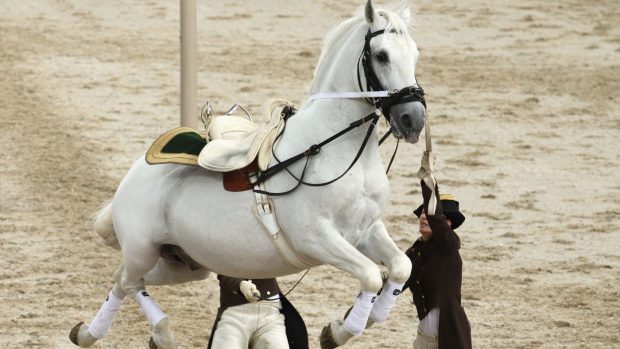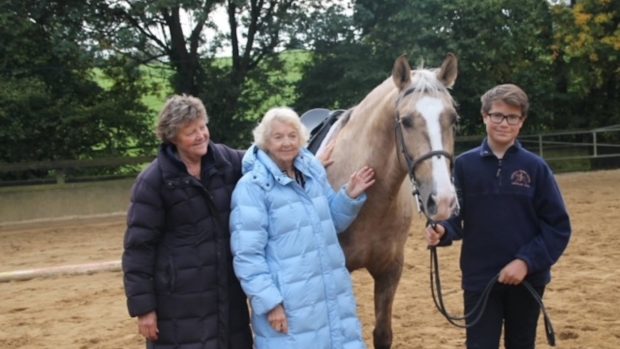Britain is unashamedly proud of its historical tradition of horsemanship. Stubbs, Van Dyck and Snaffles depict a nation of heroic horses and horse lovers. Riding is the sport of the Royal Family and horses their most treasured possessions. But when it comes to the pure art of classical riding, Britain must look to Europe to the 400-year-old Spanish Riding School of Vienna. Kings, Queens and politicians have enjoyed the spectacle of the Spanish Riding School since the fifteenth century and later this month the ballet is returning to Britain for the first time in five years.

“Its interesting for the British to see the most classical form of riding,” said Herwig Radnetter, who has trained with the Spanish Riding School since he was 16. “Everything has to happen so fast these days but our horses are trained over many years.” The Spanish lipizzaners used in the ballet account for why the Vienna-based school is known as the Spanish Riding School. Impressed by the intelligence of Spanish horses, Archduke Maximillian started to breed them in Austria in 1562, before establishing a riding school to teach young nobles the Haute Ecole dEquitation. Later this month a fleet of lorries will transport 29 white lipizzaners over to Britain, along with one lucky black lipizzaner stallion.
In contrast to reality television programmes such as Only Fools On Horses, where participants learn to ride in a few days, the Spanish Riding School trains both its pupils and horses over a period of ten years. “The horses are allowed to develop slowly, it is much better for their muscles and joints,” explained Mr Radnetter, adding that the horses are often still performing in their thirties. Lipizanners are smaller than other breeds, making them easier to train and their strong confirmation and placid temperament ensures they cope with the demands of the Haut Ecole movements.
Mr Radnetter was inspired to join the school after watching a performance in his hometown when he was a young boy. Only one or two eleves are selected each year they must be at least 15-years-old and athletically and creatively talented. Mr Radnetter had little experience with horses before his audition and was extremely surprised to be selected but the chief rider spotted his potential.
The early years were spent working in the stables and training on school stallions. Once Mr Radnetter could present a trained stallion in all the movements of the Haute Ecole (see below), he became a student rider and was assigned a young stallion to train. After six years horse and rider were accepted into the Haut Ecole itself and since then Mr Radnetter has trained countless eleves, student riders and stallions as well as performing regularly to music with the other senior riders.
Dressed in the uniform bicorne hat, brown tail coat (with a small pocket for sugar in one of the tails), long black boots and 9.5cm spurs, he will be performing along with 14 other riders in front of crowds at Wembley and Birmingham NEC. The ballet has been specially choreographed to include top dressage movements as well as the Haute Ecole off the ground movements. Young stallion Maestoso Cattinara will be performing his spectacular Capriole, while Conversano Undine I, who is blind in one eye, will form part of the pas de deux. The performance will end with the School Quadrille – eight riders performing a strictly choreographed and extremely difficult ballet, based on the carousels and knights games of Imperial times.
There is nothing to stop young British riders applying to the Spanish Riding School – applications are considered from all EU countries. “We see ourselves as cultural ambassadors for Austria on our overseas visits like this one,” explained Mag. Armin Aigner, managing director of the Spanish Riding School. “And we want to show our audiences, particularly the younger spectators, the beauty of the art of classical riding.”
The Haute Ecole Movements
- Levade – all the weight on the hind legs and no forward movement at all
- Capriole – an upward leap without going forward and with a backward kick of the hind legs at the height of the leap
- Pas de Deux two riders performing various movements with mirror-like symmetry
- Long rein the only solo performance – a particularly refined and well trained horse with his rider displays all steps and figures of Haute Ecolé without the rider, with only light guidance from the reins and crop.
- Courbette – The horse raises himself at an angle of 45° then executes one or more forward leaps on his hind legs while maintaining bent forelegs.
- School Quadrille – finale presented with eight riders. This is a relic from the times of the Carousels, all of the steps and figures are integrated in a precise and exact framework of choreography



